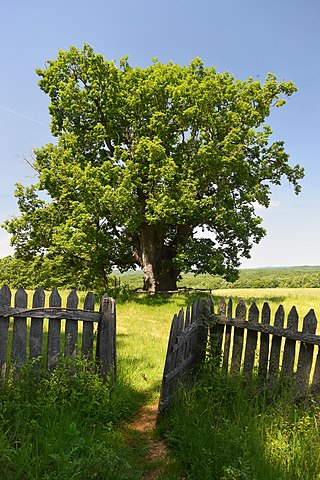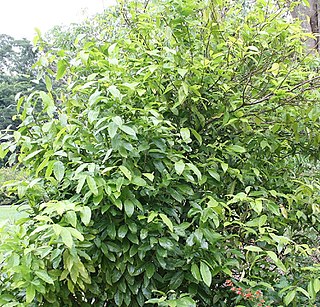
Quercus frainetto, commonly known as the Hungarian oak, is a species of oak, native to southeastern Europe and Turkey. It is classified in Quercus sect. Quercus.
Cotylelobium melanoxylon is a tree in the family Dipterocarpaceae. The specific epithet melanoxylon means "black wood", referring to the dark colour of the tree's wood. It was first described by Joseph Dalton Hooker in 1860 as Anisoptera melanoxylon and transferred to Cotylelobium by Jean Baptiste Louis Pierre in 1889. It is the provincial tree of Surat Thani Province, Thailand.

Heritiera littoralis, commonly known as the looking-glass mangrove or tulip mangrove, is a mangrove tree in the family Malvaceae native to coastal areas of eastern Africa, Asia, Melanesia and northern Australia. The common name refers to the silvery appearance of the underside of the leaves, resembling a mirror to some degree. The strong timber has uses in marine applications and elsewhere.
Vatica compressa is a tree in the family Dipterocarpaceae, native to Borneo. The specific epithet compressa means "compressed", referring to the twig when young.
Gonystylus eximius is a tree in the family Thymelaeaceae. The specific epithet eximius means "excellent".

Phaleria perrottetiana is a plant in the family Thymelaeaceae.

Dillenia alata, commonly known as red beech, golden guinea flower or golden guinea tree, is a tree in the Dilleniaceae family, found in tropical forests of the Moluccas, New Guinea, and northern Australia.
Ligustrum glomeratum is a plant in the family Oleaceae. The specific epithet glomeratum means "gathered closely", referring to the flowers.
Helicia attenuata is a plant in the family Proteaceae. The specific epithet attenuata means "drawn out", referring to the leaf base.
Helicia petiolaris is a plant in the family Proteaceae. The specific epithet petiolaris means "stalked", referring to the leaves.
Madhuca glabrescens is a plant in the family Sapotaceae. The specific epithet glabrescens means "becoming glabrous", referring to the leaves.
Madhuca montana is a tree in the family Sapotaceae. The specific epithet montana means "of the mountains", referring to its habitat.
Palaquium ferrugineum is a tree in the family Sapotaceae. The specific epithet ferrugineum means "rusty coloured", referring to the indumentum.
Diospyros lanceifolia is a tree in the family Ebenaceae. The specific epithet lanceifolia means "lance-shaped leaves".
Diospyros pilosanthera is a tree in the family Ebenaceae. It grows up to 35 metres (110 ft) tall. The twigs are slender to stout. Inflorescences bear up to 12 flowers. The fruits are round to ovoid, up to 3.5 cm (1 in) in diameter. The specific epithet pilosanthera is from the Latin meaning "with pilose or hairy anthers". Habitat is forests from sea level to 1,600 metres (5,200 ft) altitude. D. pilosanthera is found from Indochina to Malesia.
Canarium pilosum is a tree in the family Burseraceae. The specific epithet pilosum is from the Latin meaning "hairy", referring to the soft hairs of the twigs and leaves.
Lithocarpus gracilis is a tree in the beech family Fagaceae. The specific epithet gracilis is from the Latin meaning "slender", referring to the twigs.
Lithocarpus lampadarius is a tree in the beech family Fagaceae. The specific epithet lampadarius is from the Greek lampas meaning "torch", referring to the use of its twigs as torches for fishing in Peninsular Malaysia.

Salix pedicellata is a species of willow. It is a shrub or small tree to about 6–8 m tall, native around the Mediterranean Sea from Portugal to Lebanon and Syria in the north and from the Canary Islands to Tunisia in the south. Salix canariensis may be treated as a subspecies of S. pedicellata.
Symplocos fasciculata is a tree in the family Symplocaceae, native to tropical Asia. The specific epithet fasciculata means "bundled" and refers to the inflorescence.




